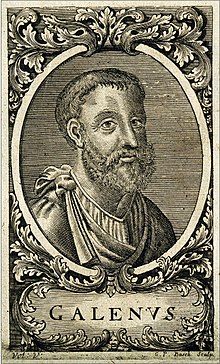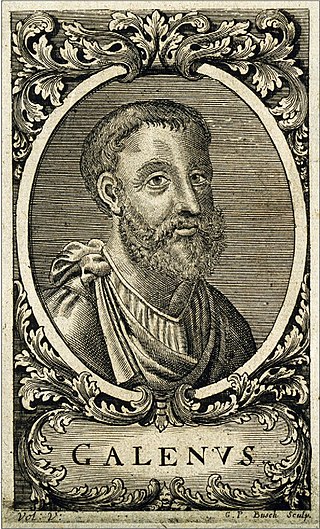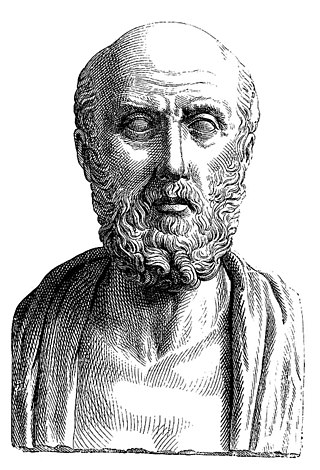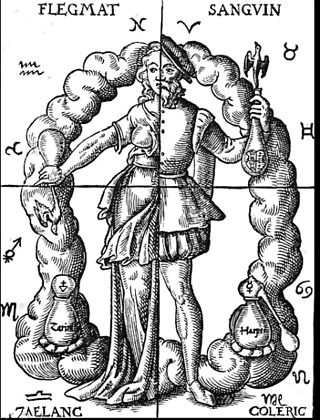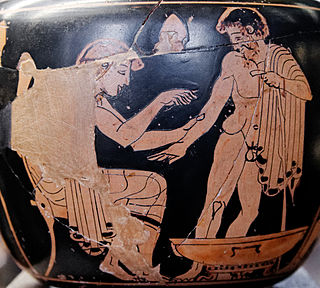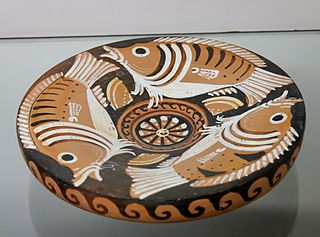Food and diet in Ancient Greece
Humours and causes of disease
Ancient Greek medicine is described as rational, ethical and based upon observation, conscious learning and experience. Superstition and religious dogmatism are often excluded from descriptions of ancient Greek medicine. [2] It is important, however, to note that this rational approach to medicine did not always exist in the ancient Greek medical world, nor was it the only popular method of healing. Along with rational Greek medicine, disease was also thought of as being of supernatural origin, resulting from the gods inflicting punishment or from demonic possession. Healing was also considered to be a gift from the gods. [3] Exorcists and religious healers were among the 'doctors' that patients sought out when they became ill. Sacrifices, exorcisms, spells and prayers were then carried out in order to reconcile with the gods and restore health to the patient.
It was not until the time of Hippocrates, between 450 and 350 BC, that rational, observational and the humoral theory of medicine began to become highly influential. [4] According to Hippocrates, diseases are derived from the imbalance of bodily substances. These substances are known as the humors. The humoral theory explains one's behavior and health conditions. The idea of humors in the human body reflected the four terrestrial elements: air, fire, earth, and water. The human body is composed of four essential substances (humors): yellow bile (fire), black bile (earth), blood (air), and phlegm (water). These humors have to be in equilibrium for our body to be in good health. Diseases can be treated by retrieving humoral equilibrium. Galen added to the humoral theory and proposed that humors explained physiological states known as temperaments. [5] These temperaments are sanguine (dominated by the humor blood), choleric (dominated by yellow bile), melancholy (dominated by black bile), and phlegmatic (dominated by phlegm). The ideal proportion to attain harmony is "one quarter as much phlegm as blood, one sixteenth as much choler as blood, and one sixty-fourth as much melancholy as blood." [6] These proportion, however, are difficult to achieve since humors are affected accordingly to what individuals consume in their body.

Foods are classified according to the humoral theory. Food is palatable when hot, wet, dry, cold are in harmony, while food is unpalatable when these elements are imbalanced. Some foods produce good juices and others bad juices and often cooking and preparation of the foods can change or improve the juices of the foods. In addition, foods may be easy to assimilate (easy to pass through the body), easily excreted, nourishing or not nourishing. [1] : 338 In Hippocratic medicine, the qualities in foods are analogous to the four humors in the body: too much of a single one is bad, a proper mixture is ideal. [1] : 347 It was believed that the choice of diet had medical consequences. Therefore, the consumption of correctly balanced foods and life-style of the patient was crucial to the prevention and treatment of disease in Ancient Greece.
Seasonal food played an important role in the treatment of ancient disease. According to the Hippocratic author of "Airs, Waters and Places" (there remains debate as to whether Hippocrates himself wrote the Hippocratic Corpus), it is important that a physician learn astronomy because, "the changes of the seasons produce changes in diseases,". [7] In the same Hippocratic text, the author goes on to explain that villages facing east and that are exposed to winds from the north-east, south-east and west tended to be healthy and, "the climate in such a district may be compared with the spring in that there are no extremes of heat and cold. As a consequence, diseases in such a district are few and not severe". [7] : 151 As an example of the importance of seasonal food on maintaining balance of the humours and preventing disease is given by Hippocrates in "On Regimen" when the authors state that, "in winter, to secure a dry and hot body it is better to eat wheaten bread, roast meat, and few vegetables; whereas in summer it is appropriate to eat barley cake, barley meat and softer foods," (qtd. in Wilkins et al., p. 346).
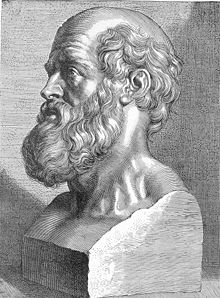
Food and diet in the Hippocratic aphorisms
Food and diet feature prominently in the aphorisms of the Hippocratic Corpus. For example, in one aphorism in the first section, Hippocrates states: "Things which are growing have the greatest natural warmth and, accordingly, need most nourishment. Failing this the body becomes exhausted. Old men have little warmth and they need little food which produces warmth; too much only extinguishes the warmth they have. For this reason, fevers are not so acute in old people for then the body is cold". [7] : 208 Another aphorism says: "It is better to be full of drink than full of food". [7] : 209 And finally, an aphorism that generally sums up treatment of disease in Hippocratic times states: "Disease which results from over-eating is cured by fasting; disease following fasting, by a surfeit. So with other things; cures may be effected by opposites." [7] : 210
This concept of treating diseases opposite to the way it manifests in the individual is concept that is carried over into Roman medicine. Hippocratic doctors encouraged the rejection of divine intervention and began to view the body more objectively. [8] This monumental stray from anthropomorphic intervention placed a greater emphasis on physicians to find a physical remedy for those in need. One of the popular remedies observed in the Hippocratic Corpus is the use of red wine. [8] Because many physicians believed that red wine paralleled blood, it could be used to provide health and comfort as a result of its "hot and dry" nature. While it was seen in a positive light, many Hippocratic physicians were also aware of the negative aspects of wine consumption along with the physical consequences of doing so. [8]
Gout in Ancient Greece
Gout, called podagra in ancient Greek medicine, is a common arthritis caused by deposition of monosodium urate crystals within the joints. [9] Gout usually affects the first metatarsophalangeal joint of the big toe and later the other joints of the feet and hands. Hippocrates considered gout to be the result of an accumulation of one of the body humours that distended the joint and caused pain. [10] He also believed gout to be a result from sexual excess or too rich a diet as alluded to in three of his aphorisms "Eunuchs do not take the gout nor become bald", "A woman does not take the gout unless her menses has stopped", and "A young man does not take the gout until he indulges coitus". [9] : 84 [10] : 14–15 As with other diseases, physicians in antiquity believed that diet was the best way to manage gout. Hippocrates recommended high doses of white hellebore because he believed that the best and most natural relief for gout was dysentery. [9] : 85 However, purging with white hellebore was probably for the more chronic cases due to the fact that wine and barleywater drinks were very strongly recommended. [10] : 16–17

Legumes in Ancient Greece
The importance of legumes in ancient Greek diet and medical practice is often disregarded. However, legumes improved the quality of the soil and were considered very important to the agriculturalists of the time. Additionally, legumes contain a high amount of albumen, which led them to be a critical dietary supplement in countries where meat was in short supply and difficult to store. Such was the case with Greece. People in the Graeco-Roman world consumed less meat than we do today and therefore, legumes were a necessary source of protein. [11] Of all legumes, the lentil appears most frequently in Greek and Roman literature. Medicinally, Hippocrates recommends lentils as a remedy for ulcers and hemorrhoids. [11] : 376
Bitter vetch, or Vicia ervilia , was also an important legume in ancient Greek medicine. The extensive medicinal qualities of the bitter vetch were thought reliable enough to later administer to Roman emperors such as Augustus. [11] : 379 Bitter vetch was thought to heal pimples, prevent sores from spreading and soothe spots or sores when they appear on the breasts. It was also reported to relieve painful urination, flatulence, liver problems, and indigestion when roasted and mixed with honey and Hippocrates cautioned that when eaten boiled or raw, the consumption of bitter vetch may cause more flatulence or pain. [11] : 379
